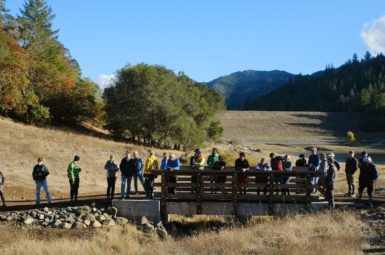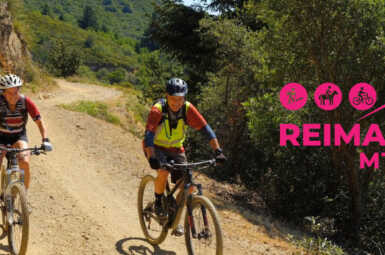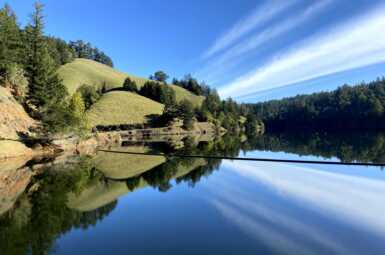Stay off trails one day for every day of rain Protect Trails Against Winter Damage – Tread Lightly!
We all know that the “Winter of 2017” has been one for the record books! Constant fronts have saturated the ground, causing undercutting and slides, road closures and creating muddy messes throughout Open Space and county park areas. Though some of us have been through significant weather impacts before, the change from drought conditions to the current soggy situation came quickly.
Before you head out on the next sunny day, let’s talk about caring for our trails and fire roads when they are most vulnerable.
Who Will Manage the Impact?
MCBC advocates for all trails to be properly designed, constructed, maintained and managed to assure that they continue to be enjoyed for decades.
Let’s focus on that last one right now: managed.
With the amount of rain we’ve received and how saturated the trails have become, many of our trails would be best off closed to all use until they’ve dried out.
But who’s going to make that call? Which agency has the immediate resources to spend significant hours posting and managing trail closures? Even if they did so, what priority would that receive among the other pressing issues of public safety?
It is up to each trail user to manage their own impact. We must manage our own habits to protect our trails.
When it comes to rain, all you need to do is use your eyes and look down. If you are leaving a pronounced mark on the trail, you probably shouldn’t ride on it.

Fire Roads are a good alternative
If you can’t wait for the rain to subside, consider staying on fire roads instead. Over the last 10 years, many of Marin’s fire roads have been repaired in an effort to reduce sedimentation caused by run-off and to harden the surface to reduce the chances of ruts forming. This is achieved with the installation of rolling dips, or grade reversals, that disrupt the downhill flow of water and push it off the side. Additionally a layer of aggregate is compacted into the tread to firm up the surface.
These roads may still experience some rutting and run-off, but in most cases the grade reversals push the silted water off the trail before it gets into creeks.

Impacts you might create when riding on rain soaked trails:
Ruts and erosion
Even the best designed and maintained trails are susceptible to damage when they are overly saturated, especially if riders follow the same line. If your tire, hoof or foot is leaving a noticeable impress on the trail, it’s best to stay off. Look for trails under canopies or in areas with a higher rock content, which tend to dry out quicker.
Widening the trail
It is best to go through a puddle rather than around it, as to go around only widens the trail. You don’t have to ride right through the center of the puddle, but try not to fully avoid it by going around.

Damage to your bike
Riding in wet and muddy conditions wears out drive trails and suspension pivots at a much faster rate. A new drive-train (rear cassette and chainrings) can easily set you back a few hundred dollars. One more reasons to keep the mountain bike in the shed when it’s muddy out. Keep an eye out for Trail Work projects to help clean things up.

Public Perception of Damage
The ground has not had a chance to dry out for months and it’s tempting to head out when there’s a little bit of sunshine. While tire treads tracks will disappear over time, they really stand out in the winter months. This reinforces the false belief that bikes cause more trail damage than other users. Numerous studies on the topic conclude that a hiker and someone on a bike have a comparable impact on a trail surface, while a person on a horse has a higher impact due to the dramatic weight difference.

Please remember that our trails are most vulnerable when saturated. We recommend staying off trails one day for every day of rain.
CLOSURES AND HAZARDS
(for reference as of 2-27-17 – it is your responsibility to determine whether conditions are safe and honor closures while on any trail system)
MMWD
SHAFTER GRADE ROAD – Impacted by a large slide. Bikers, hikers and horses may proceed with caution.
CONCRETE PIPE ROAD (between 5-corner & Bolinas-Fairfax Road) – Closed due to two major slides.
LOWER ELDRIDGE GRADE (between Filter Plant Road and Lakeview Road) – Closed. It will remain closed until repaired. Repairs may take a couple months.
UPPER PETERS DAM ROAD (between the dam and intersection with Continental Cove) – Closed due to a large fallen fir tree that has taken down PG&E and AT&T lines.
OTHER ROAD AND TRAIL STORM DAMAGE – Many other roads and trails on the watershed have suffered storm damage such as slides and downed trees. Please stay alert and use caution. Notable routes include San Geronimo Ridge Road, Deer Park Road, Old Railroad Grade and East Portal, Pine Mountain Tunnel Road, Shadyside Trail, and Fish Grade Trail.
CHINA CAMP
Shoreline Trail closed between the Ranger Station and Miwok Meadow.

TAMARANCHO
B-17 Trail – Large tree down on trail, proceed with caution.



